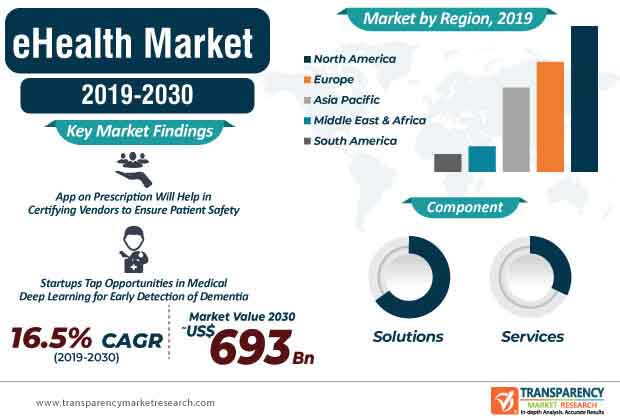
The hospitals in China have been adopting mobile telehealth systems (MTS) to enable sharing of patient information to clinicians in isolated COVID-19 (coronavirus) wards. Since doctors were unable to retrieve patient information from the hospital intranet, they resorted to mobile telehealth systems without compromising the security of patient information. More number of individuals are using telehealth and telemedicine, since people prefer remote medical services amidst the coronavirus pandemic.
Ongoing developments in mobile technologies are benefitting the proliferation of eHealth programs, thus driving the eHealth market. Telehealth systems are making it possible for healthcare professionals to share information from multiple locations. During the ongoing COVID-19 outbreak, IT companies experienced a dramatic increase in the adoption of home telehealth programs. On the other hand, the Union Health Ministry of India released telemedicine guidelines to cater the needs of hard-to-reach populations of rural India. This is anticipated to fuel the growth of the eHealth market during the forecast period.

Request a sample to get extensive insights into the eHealth Market
App on Prescription Paves Way for Secure eHealth Services in Future
The eHealth market is expected to register a staggering CAGR of 16.5% during the forecast period. This can be attributed to individuals preferring to receive medical services by the convenience of staying at home. The trend of app on prescription is bringing about a significant change in the eHealth market. Analysts of Transparency Market Research (TMR) opine that doctors will now be able to issue prescriptions for health apps to their patients and this trend will grow after the ongoing COVID-19 pandemic.
Organizations such as the National Association of Statutory Health Insurance Physicians is increasing efforts to introduce security regulations with the assistance of Federal Office for Information Security (BSI), Germany. These security regulations will play an instrumental role in the market for eHealth, since it will help to certify vendors of health apps.
Strategic Alliances among IT Service Providers Trigger Innovations in EHRs
Innovations in the electronic health records (EHRs) domain are helping companies in the eHealth market to gain global recognition. For instance, IT service provider, the BITMARCK Group, has collaborated with Austrian firm RISE (Research Industrial Systems Engineering) to steer innovations in electronic patient records (EPR) by targeting the German healthcare systems. Electronic health records, being a part of solutions in the eHealth market, is predicted to generate the highest revenue as opposed to eHealth services during the forecast period.
To understand how our report can bring difference to your business strategy, Ask for a Brochure
Government organizations are scaling the extra mile to commission IT companies that are steering innovations in EHRs. Technical implementations of the EHR are being extended toward the health insurance companies, since insurance companies need to provide its insured persons with the records at the beginning of the year. Vendors in the eHealth market are increasing their capabilities to develop EHR mobile apps for the convenience of the insured persons.
eHealth Program Implementation Success Demands Training Services During Clinical Interventions
The eHealth market is expected to reach a value of ~US$ 693 Bn by the end of 2030. However, the implementation of eHealth programs is significantly challenging for patients with chronic illnesses, as the gap between the healthcare system’s decision to adopt an eHealth program and its routine use in everyday processes is multifaceted and complex. Hence, companies in the eHealth market are warming up to the idea of adopting evidence-based health innovation programs to healthcare professionals in order to establish its routine practice.
IT companies are adopting various implementation strategies to increase the uptake of eHealth solutions, such as telehealth, laboratory management systems, and clinical decision support systems that increase productivity levels in healthcare facilities. Companies are achieving implementation success by providing training to healthcare professionals and healthcare payers about the follow-up during clinical interventions.
Companies Tap Incremental Opportunities in China to Meet Requirements of African Expats
The progress of information communication technology (ICT) in China has fueled the adoption of eHealth and telemedicine in the country. This is evident since the Asia Pacific region is projected to take an estimated leap from a revenue share of ~22% in 2020 to ~28% by the end of 2030. On the other hand, a large number of African expat community residing in mainland China is experiencing health issues due to dissimilar environmental conditions in the country. Hence, the African expat community is resorting to the adoption of eHealth.
Chinese doctors are not well-trained in the culturally adapted care sector and this issue overlooks the betterment of the African expat community residing in China. Hence, companies in the eHealth market are tapping into incremental opportunities in China.
Medical AI Helps in Early Detection of Dementia and Eliminates Surgical Interventions
Companies in the eHealth market are augmenting the advantages of medical deep learning to predict potential risks of dementia and Parkinson’s disease in individuals. Several startups are gaining proficiency in medical artificial intelligence (AI) that helps to predict possible disease patterns in patients. As such the eHealth market is primarily dominated by emerging players who dictate ~75%-80% of the market stake. This has intensified competition in the global market landscape.
A research team at the Charité – Universitätsmedizin Berlin initiated its TrueBrainConnect research project with the help of the medical AI to investigate non-invasive connections between brain regions to detect mental illnesses at very early stages in patients. Hence, IT companies should collaborate with researchers and innovators to gain efficacy in early detection of mental illnesses that eliminate the need for surgical interventions.
Read Our Latest Press Release:





